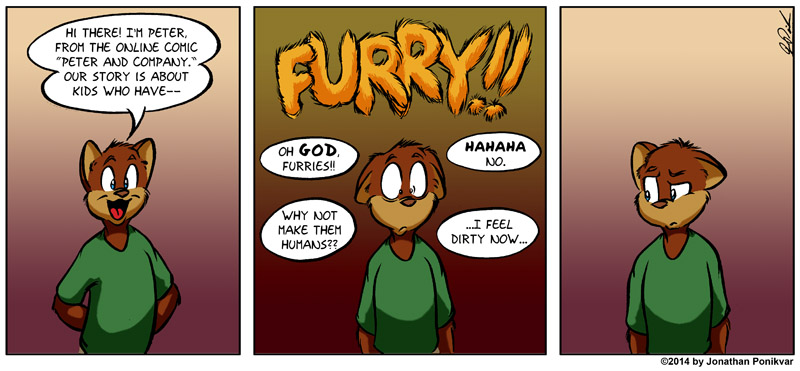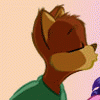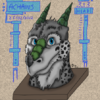Sign In
CloseThe "Furry" Problem by PeterAndCompany
This editorial was originally uploaded to Tumblr back on July 28th, 2014. I'm just now uploading it here to bring my gallery up-to-date. You can view the original Tumblr post here.
Fair warning: there is some slight language in this post.
My name is Jonathan Ponikvar. I’m the creator of Peter & Company and an avid cartoon fan; I have been trying (successfully or not) to draw them since I first discovered the magic of crayons and markers. Like most kids in the 80’s I grew up watching a crazy amount of cartoons. My favorites were the cartoons and films of Warner Brothers, Disney, and Don Bluth, so my earliest and crappiest of doodles always revolved around those characters in some way.
As I grew older and began seriously getting into cartooning, I noticed something odd going on around me: the cartoon animal was quickly becoming an endangered species. The animal designs of the 80’s and 90’s TV cartoons were being seen less and less in modern times within the industries that they helped create.
How could this happen? Are people just no longer interested in funny talking animals?
Not quite. Thanks to the internet-at-large and various programs that have fed into it, the term “furry” has now been assimilated into the mainstream culture. To those who actually take the time to learn the origins of the fandom, it means simply an appreciation for cartoon animal characters and the series that featured them throughout our lives. To everyone else, it roughly translates to a fandom entirely focused on sexual deviancy, extreme fetishes, and sexual activities that incorporate elaborate animal costumes.
I’m putting this out immediately: yes, there are those in the fandom who draw/do things related to certain fetishes that I won’t describe here. They do exist, but they are a minority, and you will find that same minority in literally ANY fandom across the entire spectrum. In truth, the furry fandom is completely benign and filled to the brim with legitimately good people. Its members are artists, illustrators, animators, craftsmen, costume designers, puppeteers, musicians, writers, professional mascots, or just simply fans of all of the above. They are members from every walk of life and have a reputation for their inclusiveness.
When I attended the Savannah College of Art and Design (SCAD), I majored in Sequential Art and earned my BFA in 2007. I intended to finish my Master’s, but had to abandon those plans in 2010 when my funds ran dry. I never was able to complete my thesis, for which I had planned to cover this very subject.
So to answer one of the questions I will inevitably receive, yes, I have definitely done my homework here.
What is the problem, exactly?
The problem lies in the fact that animation companies, game developers, and film directors now seem to be actively avoiding animal character designs because of the public stigma that has been attached to the concept of “furry” characters. It’s this association with sexual deviancy that has been brought into mainstream culture and given life thanks to shows like CSI, My Strange Addiction, and even Hardcore Pawn.
This is not something that directors and studios take lightly. History has shown that those who produce original content legitimately do listen to their audience. Thanks to the advent of social media, a production studio can now release concept art or a trailer and get immediate feedback from their fans. This has been proven to often lead to drastic changes in a product’s final design, even from massive companies like Microsoft (case in point: the XBox One’s drastic shift in DRM policies).
Every comment that is left on Youtube, Kotaku, IGN, Facebook, Twitter, or any number of other channels is visible to those who create these products. Animation studios, game developers, comic publishers. Everyone.
So what do you think goes through a Director’s head when the new project trailer goes up on Youtube, and gets inundated with comments like the following:
- “Goddamn furries, they ruin everything.”
- “I was into it until I saw the furries. Nope.”
- “HAHAHA FURFAGS ARE GONNA LOVE THIS”
This situation is not hyperbole. It is a situation that is actually happening in today’s creative industries. Modern video game projects like Dust: An Elysian Tail, Freedom Planet, and even WildStar all encountered the anti-furry sentiment, even though the latter barely features it at all.
So what happens when a studio caves in to these comments and decides to create a cardinal rule that cartoon animals are to be avoided altogether? This is also happening, and I encountered it firsthand.
When I began drawing Peter & Company in 2005, I initially planned to push it for newspaper syndication — this is why the first 75 comics in the series are in a standard four-panel newspaper strip format. During the period of time between 2005 and 2007, I probably sent out close to 30 submission packets to various publishers and syndicates across the country. They all came back as rejection letters, but one of the last ones I received included a hand-written note on the letter from one of the editors. In it, he wrote the following:
"Well done, but we’re not currently accepting talking animal strips. Thank you!"
Essentially: We love the concept and the writing! Just a shame you had to go with cartoon animals, though. Make them human and we’ll talk.
You could argue that it was silly of me to not bend to the pressure and just make Peter & Company an all-human cast, but that is precisely the problem. There shouldn’t be anything WRONG with cartoon animal characters, nor should there have to be a plot-specific reason why these animals can walk and talk. I have heard the question “Why do the characters have to be animals?” so many times over the years, both from editors and from fellow artists/students, and each time I say the same thing:
Why not?
So how do we fix the problem?
People think that the internet is so massive and limitless that their comments couldn’t possibly have any effect on things on a larger scale. What they fail to realize is that every comment is visible to everyone, and yes, content producers do read them.
Every time someone immediately replies to a product with animal characters with a knee-jerk anti-furry response, they are perpetuating the problem and adding to the reasons why modern studios tend to avoid the cartoon animal archetype. Every single one of these comments is keeping alive the false and unfair stigma of the anthropomorphic animal being a mascot for a sexually-charged fandom.
This needs to stop.
I’m not expecting this post to start a revolution or anything. I’m just hoping that those who read it will understand the problem and put forth an effort to help stop others from keeping it alive. Whenever you see someone making one of these blind comments, they need to understand what they are actually doing, and that they are the reason why modern kids aren’t growing up with the same quality of cartoons as we did.
Thank you.
-Jonathan Ponikvar
http://www.peterandcompany.com
Submission Information
- Views:
- 994
- Comments:
- 2
- Favorites:
- 6
- Rating:
- General
- Category:
- Visual / Digital





Link
Sorien
You make good points, but unfortunately... It ISN'T a minority that gets into the non-PG stuff. There is an absolutely HUGE market for pornographic (and things that can be interpreted as pornographic) material. There always has been- hell, the Disney animators are infamous for inserting really, REALLY sexual imagery and joke-panels into the films. Correcting people and changing their attitudes is made that much harder by the fact that the porn is there, will ALWAYS be there, and is unfortunately almost the face of the fandom at this point because of its prominence.
I think things can change. But what we have to do is make the point that pornography isn't a deviance. It's in ALL fandoms, all walks of life. NOT just furry. The most deviant, creepy and downright horrifying forms of porn have nothing at all to do with Furry, but have somehow been connected to the fandom.
THAT is the kind of thing that really has to change, and has to stop.
A good method to work with is this: Someone makes a stupid sexualized comment about Furry. Ask them, 'Do you like Bugs Bunny?' They'll blink and probably say yes. Then say, "Guess what? You're a furry. How does it feel?" When they deny it, say, "A furry is someone who likes imagery of anthropomorphized animals. You like Bugs Bunny, congrats, you're a furry. It isn't about sex. That's effing EVERYTHING. Stop slandering a group without understanding."
It probably won't work. But every once in a while, they'll think about it. And maybe some of them will get a clue.